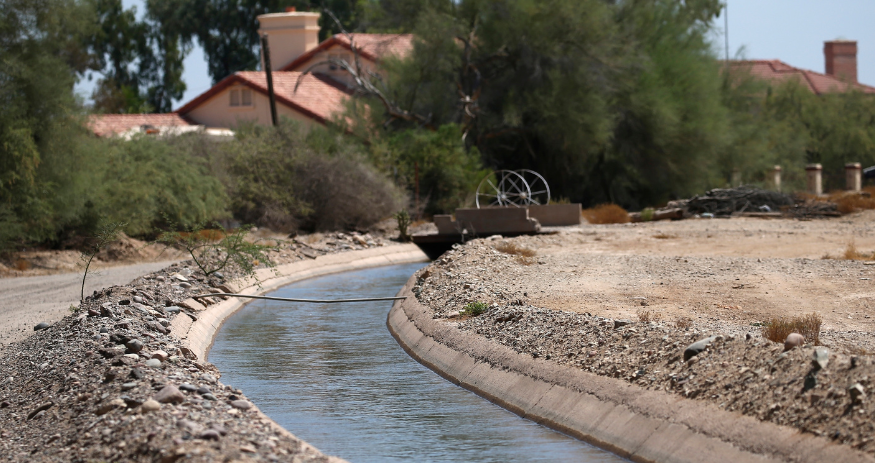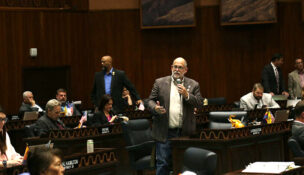With depleted funds, WIFA seeks ideas to augment water supply
Howard Fischer, Capitol Media Services//November 23, 2024//
With depleted funds, WIFA seeks ideas to augment water supply
Howard Fischer, Capitol Media Services//November 23, 2024//
They have less than half the money they were promised by the Legislature.
There’s also no guarantee that the ideas they are pursuing to increase the supply of water in Arizona actually will make financial sense.
But members of the state’s Water Infrastructure Finance Authority voted Nov. 20 to take the first step to asking companies to come up with plans to show how they could import more than 100 billion gallons of water from elsewhere to supplement, and possibly replace, some of what is being used now to supply homeowners, industrial users and farmers.
What the board wants from them are not just meaningful of how these companies technically could bring water to the desert. They want to know the price tag.
One thing is for sure: It’s going to cost more than Arizonans are paying now for the mix of groundwater and surface water that comes out of their taps. But the fact is that may end up being the only option as local water supplies are drying up and even the future of the state’s Colorado River allocation remains uncertain.
“Other” alternatives
What WIFA is pursuing is what remains of a grandiose $1 billion plan by former Gov. Doug Ducey to have the state desalinate water from the Sea of Cortez in Mexico. That resulted in behind-the scenes negotiations by the WIFA board solely with Israeli-based IDE Technologies in a bid by the then-governor to have a deal inked by the time he left office in January 2023.
That all blew up when word got out and board members concluded they didn’t have enough information.
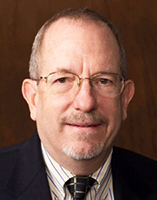
Now all of that is starting over, complete with an open solicitation process and no pre-baked decisions that desalination is the answer. Ted Cooke, a WIFA board member who chairs the committee, said the panel is open to ideas ranging from bringing in surface water from other states, reclaimed water and “other.”
“So there’s an ‘other’ there which means anything,” he said.
“We want to have an open mind to have innovative ideas that go beyond the obvious ones,” said Cooke. “And even the obvious ones have lots of potential regulatory, legal, political, permitting-type challenges.”
But the bottom line, he said, is making sure that any of these ideas actually are viable.
At the heart of the problem is a convergence of several factors.
The obvious one is that Arizona is growing. And while some of the need for residential use can be met by retiring farmland, that isn’t always an option.
Related to that is a recognition that groundwater is not an infinite resource.
Then there’s the fact that the drought is putting less water in the Colorado River. And the state, which already has had its allocation reduced, is virtually certain to have to take future cuts.
Cooke said some studies have shown the total anticipated “unmet demand” for the entire state could be as high as 5 million acre feet, with an acre foot being the amount of water that could serve two or three average families a year.
And a more focused study of the areas served by the Central Arizona Project showed projections of a need of between 100,000 and 500,000 acre feet within 10 years.
All that was on the minds of Arizona lawmakers when they voted in 2022 to set aside $1 billion over three years for water augmentation projects, with a mandate that at least 75% of it comes from outside the state.
Allocation Cut in Half
The only thing is, Gov. Katie Hobbs, looking for places to cut funding, trimmed last year’s allocation by half and eliminated entirely this year’s $333 million payment. Chelsea McGuire, an assistant director at the agency, said that leaves the agency with about $450 million.
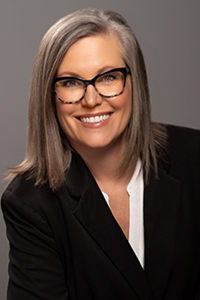
There’s really nothing that can be built for that amount. In fact, even the $1 billion was seen only as a form of state participation: Estimates from that now-defunct Israeli plan put the price tag in the $5.5 billion range.
So what that leaves at this point is to use WIFA’s money to find someone who has the technical expertise, has a viable plan and is willing to use at least some of its own funds to build.
What’s needed to make that work for any company ultimately chosen by WIFA, however, is having guaranteed long-term customers. And that turns on the billion-dollar question: How much are water users willing to pay.
The average monthly water bill for Phoenix is about $45 a month. It’s pretty much the same for Tucson.
Multiply that out by 12 and you’re talking $540 a year. That covers everything from producing and treating it to maintaining the system that delivers it to the door.
By contrast, estimates for desalination projects put the cost of treating and delivering an acre foot of water at anywhere from $2,500 to $5,000 an acre foot. Even assuming conservative use of water and that three families can be served with an acre foot, that means adding anywhere from $830 to $1,600 extra a year to a water bill.
At the same time, there are other costly but less expensive alternatives being explored to increase the supply of domestic water.
One of the most talked about is “advanced water purification,” sometimes more colorfully referred to as “toilet to tap.” In fact, the state Department of Environmental Quality just published the draft rules for taking water which just a few days earlier had been flushed down the toilet and delivering it to water faucets.
It’s already a viable technology.
Scottsdale has a plant that is treating sewage to drinking water standards, though actually delivering it to people’s homes will require a DEQ permit. And Phoenix is retrofitting one of its sewage treatment facilities to produce potable water.
Cooke noted that while the law authorizing WIFA to find water requires that 75% come from out of state, that still leaves room for it to be exploring options like this.
“Ideally, we would have some idea of what are the viable options out there for in-state augmentation so we can compare the two and make the choices before we’re fully subscribed to go out and get $4,000-an-acre-foot water for the whole 500,000 acre feet that we think that we need and no longer have the means or the opportunity to do something less expensive,” he said.
Unlimited Scope
There’s also the belief that once the state starts getting proposals to augment the water supply from an out-of-state source, someone may come up with something quite different that has not even been considered. Jonathan Lines, who chairs the WIFA board, said that’s exactly what the request for solicitations issued this past week deliberately does not spell out the technology to be used.
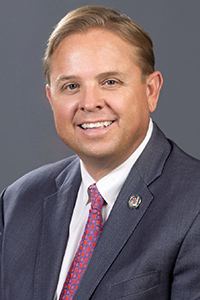
“We’re not limited in scope or specifics,” he said. “And we want to do what makes sense for Arizona long term, with no commitment today on what that path forward looks like.”
But there’s another factor at work that could affect what the water will cost, whether it will be affordable and even how many proposals the state will get: that failure of the state to live up to its commitment for $1 billion.
McGuire said the message that goes out to those who might want to get involved is that “Arizona clearly isn’t serious about this.” And that, she said, will make some of them believe it is not worth their time to submit a proposal.
The other side, McGuire explained, goes to the huge capital cost of such a project, whether desalination, a water pipeline from the Midwest or something else.
“We’re going to have to play some role,” she said, having the state invest its own cash.
Put simply, McGuire said any private developer forced to pick up all the costs would want a rate of return on that investment. And that, in turn, will drive up the costs of delivered product to the point that no one will be willing to commit to long-term purchases.
“And so those end users like a Phoenix, whoever it might be, they say, ‘Well I don’t know that I can afford that,’ ” she said.
Conversely, putting public dollars into those capital costs means the risk for the developer goes down as does how much that entity needs to charge.
“So state support is what makes this sustainable and financially feasible across the board.”
That, then, comes back to WIFA’s finances.
Recognizing the state budget situation, WIFA didn’t even bother to ask Hobbs to put money to restore the cuts in her budget for next fiscal year.

“Instead of ‘give us more,’ we’re asking for a ‘do no more harm’ approach,” said McGuire. In the meantime, she said, the WIFA board members will do what it can to show the governor and lawmakers that they are using the money they do have to show there are “tangible concepts” out there to pursue.
“So we’re dedicated to showing our work, showing the value of the investment so far, before we ask for more,” McGuire said.
Hobbs, for her part, was noncommittal on future funding.
“We’re in the middle of our budgeting process right now so I can’t speak to what that investment’s going to look like,” the governor said. But she insisted she is not trying to kill the plan.
“I am absolutely committed to our water security,” she said.
“Water augmentation is an important part of that future,” the governor continued. “We are absolutely moving forward on feasible plans for augmentation.”
There’s something else in how WIFA is conducting its business that is a bit unusual.
In most solicitation requests for goods and services, a government agency puts out a request for what it wants and asks firms to say what they would charge.
In this case, however, WIFA intends to select those they want to hear more from about their ideas and plans. And at that point the agency actually will cover their expenses of proving the engineering and cost viability of their projects.
McGuire said that’s necessary given the scope of the work being sought.
“To have that wholly flushed out and fully developed, I don’t think it’s something that a firm really is going to do for the state without some sort of compensation for doing that,” she said.
McGuire also said that by putting these firms on contract to do a feasibility analysis of their proposed projects and giving WIFA the information it wants means the state will be getting “apples-to-apples” information to compare and contrast them.
“The other thing that it means is we also own that intellectual property at the end of the day because those teams are on contract to work for us,” McGuire continued. And that, she said, means that if WIFA does not find what has been submitted to be acceptable, the agency gets to keep and use all that research to pursue alternatives.

